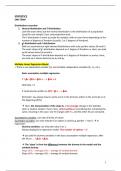Samenvatting
Statistics for Pre-Master TISEM Tilburg University Summary
- Instelling
- Tilburg University (UVT)
All the content, tests, formulas and important information to pass the exam. Besides this summary, I advise you to practice with old exams. Good luck!
[Meer zien]




